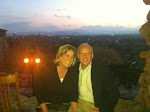Church buildings have been a part of my life since day one. Even today I like churches that look like churches. The popular wisdom these days says that churchy architecture is off-putting and must be overcome in order to reach people who don’t know much about church or (most importantly) Jesus. I get that – but I’m not sure I buy it.
I like steeples and stained glass. I like the word “sanctuary.” There’s actually meaning in it, something rich and deep in the Latin root sanctus, “holy.” It is certainly true that windows and walls and furniture do not make a space sacred, but it feels right to me when our sacred spaces evoke a sense of quiet awe.
The challenge is keeping the awe of sacred spaces connected with a sense of joy. One of the first things I learned about church buildings when I was very young was that you don’t run in the church. Even now when my kids go full throttle down the runway length hall at Peachtree, I cringe. Some years ago, after singing with the children’s choir in Sunday morning worship, my son leaped from the chancel, vaulting over the stairs and landing with a thump on the sanctuary floor. I was laughing and horrified at the same time. You don’t run in church. You don’t jump in church. But that’s too bad. The sacred ought to move us to the kind of delight that runs and jumps, what Jesus might have had in mind when he urged us to become like children.
********
In the earliest pages of scripture God commanded his people to construct a place of worship. The earliest structure was the Tabernacle. It was portable, but sacred nonetheless. Much later on the Tabernacle was replaced with a more permanent structure, the Temple. In each of these sacred structures a particular place was regarded as especially holy. The high priest was the only person who had access to this holy place, a place known as the Holy of Holies. A place closed off from the people, separated by a large heavy curtain. ‘Do not enter’ signs clearly posted.
And on the day Jesus died on the cross, that heavy curtain was torn in two, ripped from top to bottom. The barrier was broken, the ‘do not enter’ signs came down, and holiness spilled out all over the place on everyone and everything.
In Athens Paul was surrounded by sacred structures – temples and shrines to this god or that. In his eloquent introduction of the resurrected Jesus, Paul was clear on this point: God does not dwell in temples built by human hands (Acts 17:24). Shelters and shrines and domes and walls cannot contain the God who created the universe.
We are far more likely to see God in the everyday when we truly understand that God does not dwell in a building. God doesn’t camp out under a steeple and wait for us to show up. God does not hide behind stained glass. God isn’t roped off, contained behind a barrier or railing or under a high arched ceiling.
God dwells in the places you will inhabit today: Offices and malls, bedrooms and backyards, cars and conference rooms, warehouses and theaters. Paul summed it up nicely. “He is not far from each one of us” (Acts 17:27). Wherever you are today, God is there. It is for us to search, reach, and find.
Prayer:
We are thankful, O God, that you do not dwell in buildings and wait for us to show up. You have sought us out, coming to us in Jesus. Even now, your Spirit finds us wherever we may be. Teach us to be attentive to your presence, seeing signs of your work around us every day in the everyday. Amen.

No comments:
Post a Comment